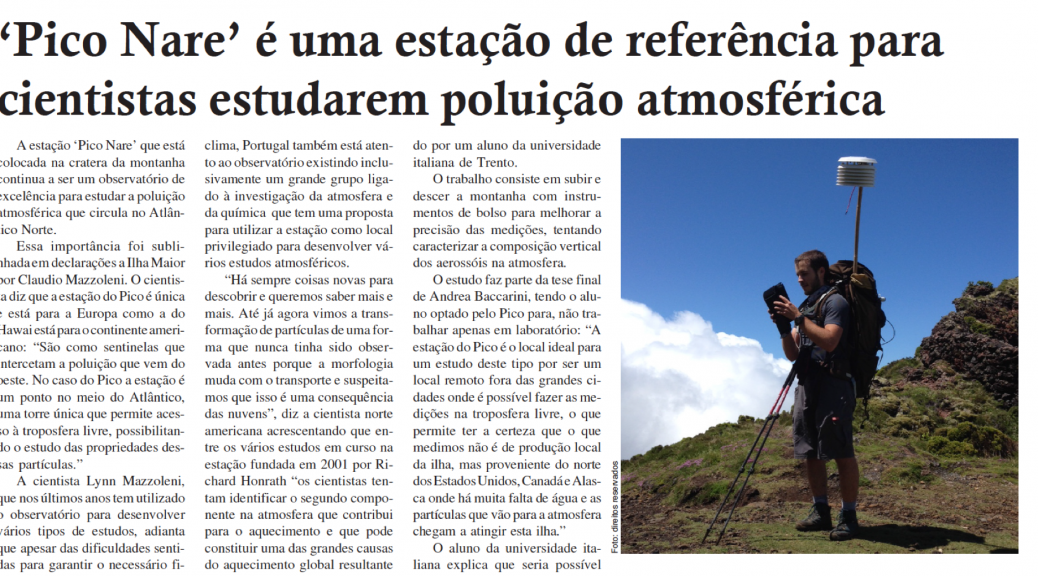Andrea Baccarini , Claudio Mazzoleni e Lynn Mazzoleni foram entrevistados por David Borges, um repórter de um jornal local em Madalena, em julho de 2015. Aqui está a história jornal que resultou da nossa conversa.
Publican em 4 de setembro de 2015 (English Version Available)
‘Pico Nare’ é uma estação de referência para cientistas estudarem poluição atmosférica
Escrito por David Borges, Ilha Maior
A estação ‘Pico Nare’ que está colocada na cratera da montanha continua a ser um observatório de excelência para estudar a poluição atmosférica que circula no Atlântico Norte.
Essa importância foi sublinhada em declarações a Ilha Maior por Claudio Mazzoleni. O cientista diz que a estação do Pico é única e está para a Europa como a do Hawai está para o continente americano: “São como sentinelas que intercetam a poluição que vem do oeste. No caso do Pico a estação é um ponto no meio do Atlântico, uma torre única que permite acesso à troposfera livre, possibilitando o estudo das propriedades dessas partículas.”
A cientista Lynn Mazzoleni, que nos últimos anos tem utilizado o observatório para desenvolver vários tipos de estudos, adianta que apesar das dificuldades sentidas para garantir o necessário financiamento o observatório não irá fechar. Segundo a cientista da Michigan Tech (universidade no michigan), além do interesse dos Estados Unidos em tudo o que se relaciona com o clima, Portugal também está atento ao observatório existindo inclusivamente um grande grupo ligado à investigação da atmosfera e da química que tem uma proposta para utilizar a estação como local privilegiado para desenvolver vários estudos atmosféricos.
“Há sempre coisas novas para descobrir e queremos saber mais e mais. Até já agora vimos a transformação de partículas de uma forma que nunca tinha sido observada antes porque a morfologia muda com o transporte e suspeitamos que isso é uma consequência das nuvens”, diz a cientista norte americana acrescentando que entre os vários estudos em curso na estação fundada em 2001 por Richard Honrath “os cientistas tentam identificar o segundo componente na atmosfera que contribui para o aquecimento e que pode constituir uma das grandes causas do aquecimento global resultante de incêndios ou de outros tipos de combustão”.
Além deste trabalho um dos estudos em curso atualmente na ‘Pico Nare’ está a ser desenvolvido por um aluno da universidade italiana de Trento.
O trabalho consiste em subir e descer a montanha com instrumentos de bolso para melhorar a precisão das medições, tentando caracterizar a composição vertical dos aerossóis na atmosfera
O estudo faz parte da tese final de Andrea Baccarini, tendo o aluno optado pelo Pico para, não trabalhar apenas em laboratório: “A estação do Pico é o local ideal para um estudo deste tipo por ser um local remoto fora das grandes cidades onde é possível fazer as medições na troposfera livre, o que permite ter a certeza que o que medimos não é de produção local da ilha, mas proveniente do norte dos Estados Unidos, Canadá e Alasca onde há muita falta de água e as partículas que vão para a atmosfera chegam a atingir esta ilha.”
O aluno da universidade italiana explica que seria possível realizar o trabalho mesmo que não houvesse a estação do Pico, porque os instrumentos podem ir no bolso. No entanto esclarece que a ‘Pico Nare’ contribui para de forma mais precisa comparar e confirmer as medições com as dos instrumentos de bolso.
Andrea Baccarini não sabe quando é que terá conclusões para apresentar, mas espera que até final do ano ter conseguido trabalhar todos os dados recolhidos e apresentar os resultados o mais rápido possível.
